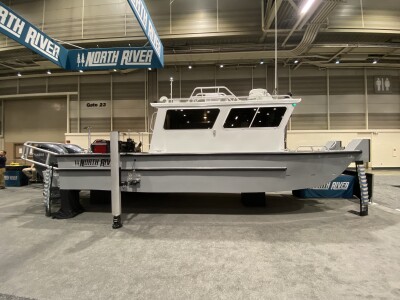The National Marine Fisheries Service extended a “slow zone” voluntary vessel speed restriction zone southeast of New York Harbor on Wednesday, with escalating pressures to do more for protecting the extremely endangered northern right whales.
The speed zone notification, calling for vessels over 65 feet to maintain 10 knots or less, was already in effect when an acoustic buoy monitored by the Woods Hole Oceanographic Institute again detected right whales in the New York Bight, NMFS said in a Dec. 9 notice to mariners. The agency earlier issued a Nov. 20 alert for an area southeast of Atlantic City when sensors picked up right whales there.
A recent reassessment of the right whale population estimated the animals’ number at 366, with 94 females of breeding age, down substantially from 400 individuals – at that number, already one of the most endangered species on Earth.
NMFS is under intense pressure to do more to protect the whales under the Endangered Species Act, with vessel strikes and fishing gear entanglement topping human interactions.
The agency has proposed new gear and area restrictions in New England lobster fishery areas, and environmental groups are pushing for action.
The ship speed slow zones are voluntary, but reports from U.S. and Canadian conservation groups say speed restriction advisories appear to be ineffective and even widely ignored by ship operators.
The first documented northern right whale born in the 2020 calving season was found dead on a North Carolina beach Nov. 20. There was no sign that any human interaction played a role, but the loss is one more pressure point in efforts to protect the extremely endangered species.
The National Park Service reported finding the dead calf stranded on North Core Banks in the Cape Lookout National Seashore. Results from a necropsy performed by a team North Carolina State University, the state Division of Marine Fisheries, North Carolina Maritime Museum, National Park Service, and University of North Carolina Wilmington suggested the animal died during birth or shortly after, according to the National Marine Fisheries Service.
The team collected several genetic samples to possibly identify the calf’s mother. The estimate for the entire northwest Atlantic right whale population was recently downgraded to 366 animals, and the New England Aquarium maintains an extensive catalog of photos and biological data about the survivors.
Since 2017 at least 32 dead and 13 seriously injured right whales have been documented by NMFS. During the whales’ calving season off the U.S. Southeast coast, mothers and calves are intently tracked by researchers.
During the 2019-2020 season 10 calves were born, more than usual and raising hopes among conservationists. But one of those was lost in June to a vessel strike off New Jersey.
Across the nearshore New York Bight and inside the harbor up into the lower Hudson River, mariners, whale watchers and fishermen reported intense whale activity throughout 2020.
Sightings of humpback whales correlated with big schools of menhaden, a favorite prey fish for the mammals. This week New York Media Boat’s Bjoern Kils captured stunning images of a humpback cruising past the Statue of Liberty.





